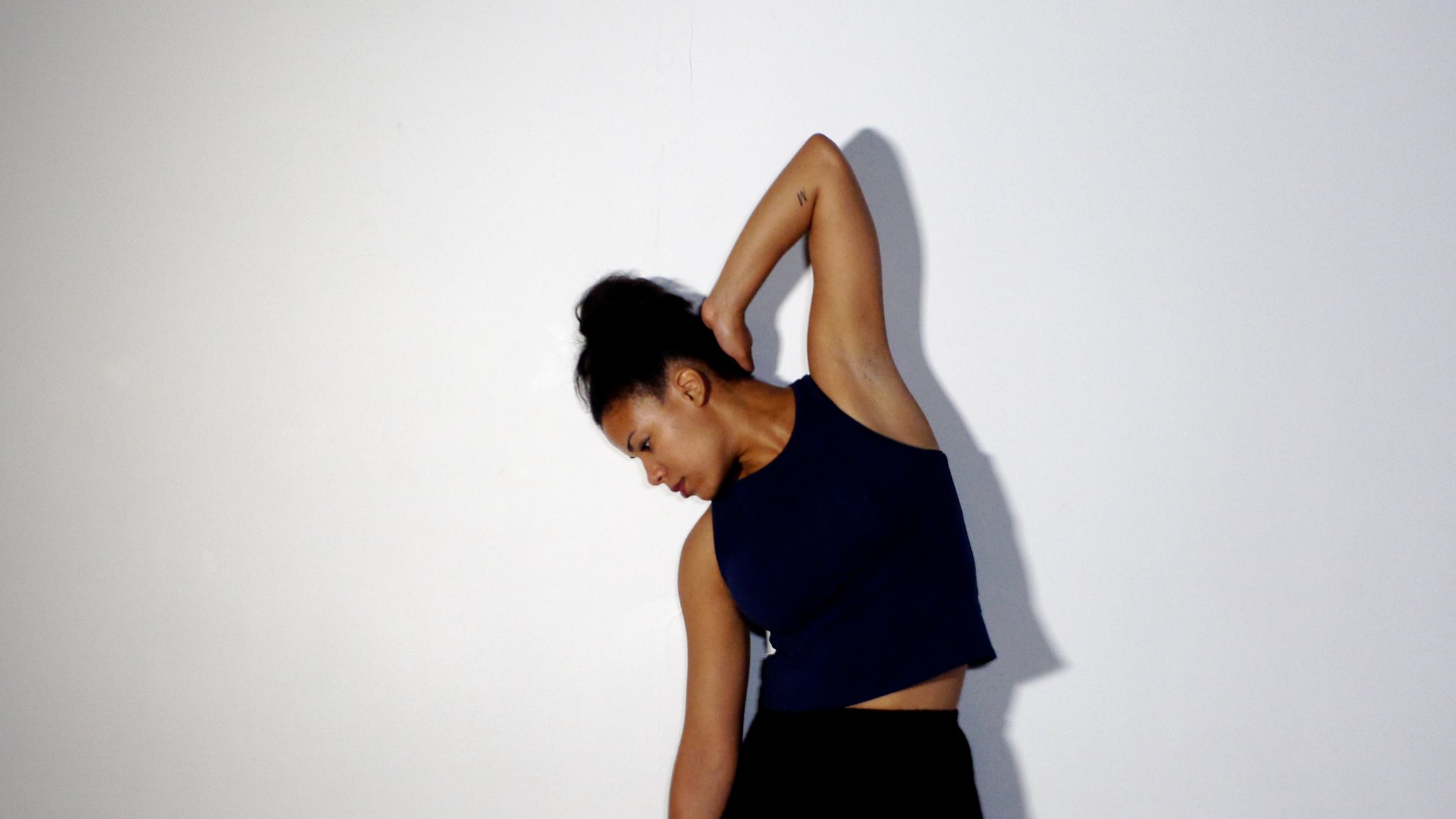Author’s note: To read additional coverage of the 2018 Midwest RAD Fest, click here.
KALAMAZOO, MI — Each of RAD Fest’s four juried live performances asked audience members to travel from the Epic Center’s Wellspring Theater to the Judy Jolliffe Theater across the hall, a flexible blackbox with gleaming, gorgeous wood floors. We’re told to stand or sit wherever we like, which naturally means that everyone scatters to the perimeter save one or two brave souls who sit close. The festival’s performances on Saturday offered two starkly different pieces who shared this place of honor at the end of a program, with Phoenix-based Leanne Schmidt and Marlene Strang closing the first performance, and New York’s Marissa Brown last on the second.
These two works shared a seating arrangement — a pretty tight semi-circle that doesn’t quite define a front — but that’s about it. Schmidt and Strang’s Cluster Feed is a hilarious, self-deprecating duo that invites audience members to approach a microphone and tell them a joke, or compliment their hair, or tell them how to get rid of a muffin top. Favorite joke: “What’s the difference between a snow man and a snow woman? Snow balls.”
Anyway, the two women, dressed in silly, mismatched outfits, ping-pong between serious concert dancing and put-on personas which channel Edina and Patsy from Ab Fab, or maybe Ilana and Abbi in Broad City (for the younger lot). Their apparent need for approval by us — begging for help once, asking us if we want toast many more times — is only staved off by them wholly embracing their own ridiculousness.
It works, as does Brown’s solo dance to Mozart’s Requiem, though I hesitate to think that any dance can (or should) actually fill this magnificent score. Brown is unadorned, wearing a simple tank and stretchy shorts. She picks and chooses from Mozart’s swells, accentuating those which speak to her the loudest, and makes deep (really deep) lateral lunges again and again, positioned just inches from the crowd. Brown looks her audience straight in the eyes, and holds out her palm, almost like asking for alms for the poor, daring these viewers to not stare back at her.
The piece is called The Endless Succession of Hours, and particularly in its place as the last dance in the festival, it gave me pause to think about the power dynamic between the audience and performers. Who holds the power, really? Is it with the artists, whose relentless gaze in our direction demands our attention, or with those who can opt to give it, or not?
An impossible question to answer, really, though Daniel Burkholder’s Is This Enough? in RAD Fest’s late night show Saturday also presumes to ask. He enters in rehearsal clothes — a t-shirt and sweats — and asks if anyone in the audience is the same age as him, 49. He engages in a conversation with a woman who we learn is named Abby, the only one who answers. Burkholder then talks as he dances, reflecting on his three-decade career, noting the paradox of what success looks like in dance and reflecting a bit, on his similarities with Abby. Case in point: Burkholder’s been employed by Trader Joe’s twice, once at the same time that he was elected an artist-in-residence at the illustrious Kennedy Center in Washington, D.C. He’d literally go stock shelves at four in the morning, then go make dances for one of the most well-respected venues in the country. How’s that for irony?
Bethany Wells Bak and Lauren Curry offer a funny, but poignant duet about an Irish goodbye (what we now, I guess, call ghosting), while another duet, called Duet Again by Miguel Alejandro Castillo and Andrew Pester lets an audience member pick whether their dance will be accompanied by ABBA, The Mommas and the Pappas, Joni Mitchell or Simon and Garfunkel (an impossible choice, if you ask me). Yet another duet, the best bits from Jessica Miller Tomlinson’s Berseluk-Beluk tugs at Eastern and Western aesthetics, while two solos, Julius Brewster Cotton’s Souls That Never Shall Meet and Ethan Barbee’s The Golden Ratio place each man at odds with himself (Both are most striking in their final moments).
Yeah, so, permission and power are at play in Saturday’s two shows, but also the crux of the genre called “dance for the camera.” A component of RAD Fest included a free viewing of screendances, selected through a competitive process and presented Saturday afternoon at the Kalamazoo Institute of Arts. Unlike live performance, which affords the audience with quite a bit of autonomy, dance on film more directly instructs viewers as to what the choreographer and/or director wants us to see. Screen dances go one step beyond what light or costume can do onstage, which somehow shifts the dynamic between artist and audience.

In some ways, that’s really refreshing. A ubiquitous squabble between artists and their viewers is artists’ comfort with ambiguity, while folks outside the dance world often want to be told what they’re seeing. There’s room for compromise on both sides, but dance on film can, in my view, more easily slog through the muck without need for an explanation. Maybe it’s the separation of time and space from the performers — when contrasted with Brown’s dance in the Judy Jolliffe Theater, the performers don’t actually know if you’re looking back at them or not. This perhaps gives us the confidence to gaze, to remain open and curious, to slog along with you.
—
Live performances and workshops of the Midwest RAD Fest continue through Sunday at the Epic Center, 359 S Kalamazoo Mall, Kalamazoo, MI. Tickets are $15 for individual events, $25 per night, or $45 for a festival pass. For more information and a full festival line-up, visit www.midwestradfest.org.
